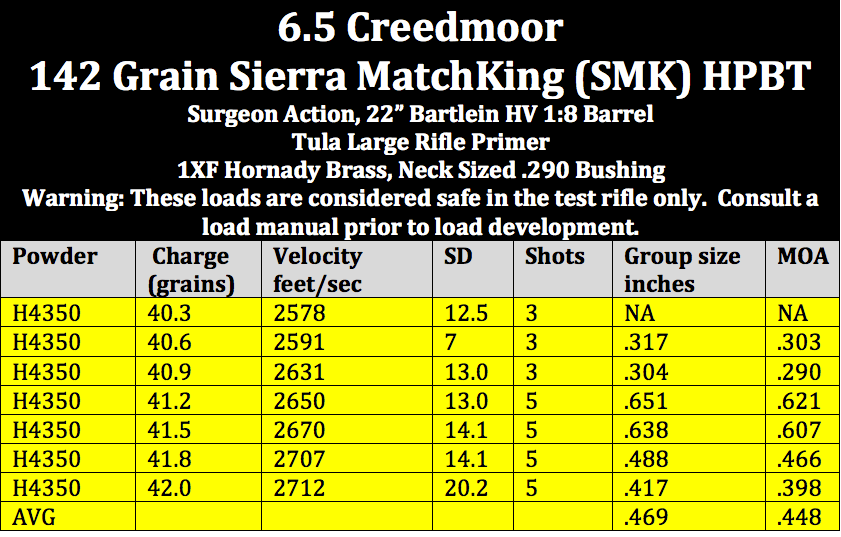
I worked up some loads for my custom 6.5 Creedmoor precision rifle with a 22″ barrel using Sierra’s 142 Grain MatchKing (SMK) HPBT and Hodgdon H4350 powder.
According to Sierra, the 142 grain SMK has a sectional density .291, and G1 bc of .595 above 2850 feet/second and .580 between 2850 and 2400 feet/second.
The rifle is built with the following components from Brownells:
- Surgeon 591 action
- Bartlein 6.5mm 1:8 twist HV barrel
- Badger M5 bottom Metal
- Timney 510 trigger
- McMillan A5 stock
It is topped with the outstanding Nightforce BEAST 5-25 FFP mil/mil scope in Nightforce rings.
To see how I built the rifle, check out Building a Custom 6.5 Creedmoor Precision Rifle.
WARNING: The loads shown are for informational purposes only. They are only safe in the rifle shown and may not be safe in yours. Consult appropriate load manuals prior to developing your own handloads. Rifleshooter.com and its authors, do not assume any responsibility, directly or indirectly for the safety of the readers attempting to follow any instructions or perform any of the tasks shown, or the use or misuse of any information contained herein, on this website.
Hodgdon H4350 seems to be the popular powder choice for heavier bullets in the 6.5 Creedmoor, so this is the powder I selected. Brass is 1XF Hornady, neck sized in a Redding full length neck size die with a .290 titanium nitride bushing (note: the I did not use the FL die to set back the shoulder). Powder charges were dropped with a Harrell Classic Culver powder measure. A Redding competition seat die was used to seat the bullets on a Forster single stage press. Tula primers were seated by hand with a Sinclair priming tool.
Seating depth of the bullets was .030″ short of the ogive touching the rifling, 2.800″ OAL. To measure the distance from the bullet’s ogive to the lands, I used a Hornady OAL gauge. As a rule, I don’t like to jam bullets into the rifling.
All shooting was done prone, from a Harris BR bipod equipped with a Pod-Lok, with a rear bag. Temperature was 80F, humidity was 36% and it was a sunny day.
Velocity information was collected with a MagnetoSpeed barrel mounted ballistic chronograph.
Results are shown below.
Since I am mostly interested in the faster loads, I only loaded three rounds for the first three loads, and five rounds of each combination for the last four.
Average groups size for the six loads that were measured is shown in the lower right hand corner of the table. Average group size in minute of angle (MOA) was calculated by converting the average groups size in inches to MOA.
Standard deviation values shown in the table repeat themselves twice. This was not a transcription error, the values shown are correct.
The first load, 40.3 grains of H4350 was shot on a clean barrel as a fouling shot. The group was close to an inch counting the first round, so I discarded the 3-round groups size since I do not believe I had enough data to give an accurate indication of the loads performance.
The 40.6 and 40.9 grain H4350 loads were excellent, however, these were only three shot groups and the velocity was 100 feet/second slower than the loads on the upper end.
The 41.8 and 42.0 grain H4350 loads look promising. These are .3 and .5 grains respectively over Hodgdon’s maximum published load, however, they were safe in this particular rifle and I did not have any indications of excessive pressure.
The velocities 2707 and 2712 were comparable to those I achieved with the 136 grain Lapua Scenar-L, but with an extra 6 grains of bullet weight that translates into better downrange performance. For comparison purposes, I ran the ballistic calculator for the 142 grain SMK and 136 grain Scenar-L in the test gun using G1 ballistic coefficients (BC) at 1,000 yards. The 142 SMK (2712 feet/second) drops 338.0″ and has 79.5″ of drift in a 10 mile/hour crosswind. The 136 Scenar-L load (2704) has 354.8″ of drop and 87.8″ of drift in the same conditions.
I am pleased with my initial findings and well be heading back to the range to fine tune this 142 SMK load. Keep in mind, this is a relatively short, 22″ barrel. Longer length would yield higher velocities.












You must be logged in to post a comment.